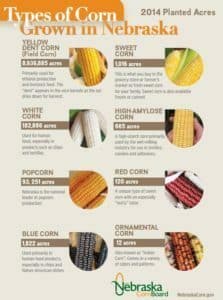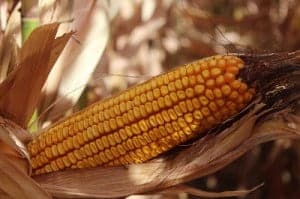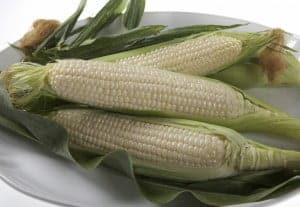Whatkgjt Happen if Upu Planted Rows of Sweet Corn Next to a Felield of Cron Grown for Animal Feed
There's more to Nebraska corn than meets the ear. 
Drive across Nebraska during the summer and fall and you'll see miles and miles of corn fields. But did you know that more than 99 percent of that corn is "field corn" and won't directly end up on your plate for dinner or popped with a little butter and salt for a night at the movies? The other 1% of corn grown represents 7 different types of corn. To the right is an infographic, showcasing these different types and the numbers of acres grown in Nebraska. Click here to see a full-page image or download a copy.

Field corn is the classic big ears of yellow dented corn you see dried and harvested in the fall. In fact, it's sometime called "dent corn" because of the distinctive dent that forms on the kernel as the corn dries.
Field corn has dozens of uses, but it is most commonly fed to animals or used to make renewable fuels like ethanol to power our cars and trucks. But only part of the kernel is used for ethanol (the starch), the rest of the kernel, including the protein and fat, are then used to make another popular animal feed known as distillers grains.
People don't eat field corn directly from the field because it's hard and certainly not sweet. Instead, field corn must go through a mill and be converted to food products and ingredients like corn syrup, corn flakes, yellow corn chips, corn starch or corn flour.
While 99 percent of the corn grown in Nebraska is field corn, there are dozens and dozens (and dozens) of varieties available for farmers to plant. Some have a shorter growing season from planting to maturity, and some are longer. Some handle certain soils better than others, and many have ways to protect themselves from insects and disease.
Sweet Corn
Less than 1 percent of corn grown in Nebraska is sweet corn – the type of corn people eat. We're talking corn on the cob, frozen corn and canned corn. Sweet corn is bred to have plump, juicy kernels that include a high level of natural sugar when compared to field corn. It's that sugar that gives sweet corn the flavor we all love.
While field corn is harvested when mature and dry (so it can be transported and stored), sweet corn is harvested when the kernels are young and moist.
Popcorn
Only about 220,000 acres of popcorn are grown each year in the United States, and Nebraska is the number-one producer in the country, harvesting some 300 million pounds of popcorn on roughly 67,000 acres.
Each kernel of popcorn contains a small amount of water stored inside a circle of soft starch. When the kernel heats up in the microwave, air popper or on the stove, the water expands until the kernel bursts open to create a light, delicious snack. Americans consume 16 billion quarts of popped popcorn annually – that's 51 quarts per every man, woman and child!
White & Specialty Corn
Some varieties of corn are developed and grown for very specific purposes. Specialty corn is often grown with the specific end use in mind, with farmers contracting with buyers in advance of planting the crop. This helps farmers have a market for the corn and buyers are able to ensure they'll have corn for their needs.
White corn features a harder than normal starch is used in corn chips, tortillas and other popular food products. Nebraska is one of the top producers of white corn in the United States, with farmers here growing white corn for food and other companies across the country and even some foreign countries.
Some types of corn have been designed to include high levels of starch. This high-starch corn is perfect for ethanol production because ethanol is made from the starch, leaving the other parts of the kernel for distillers grains, a nutrient-rich feed for livestock.
Still other corn is bred to have high amounts of oil in its kernels. This high-oil corn is great for certain types of food processing or animal feed.
Waxy corn is used to thicken foods and make adhesives, while high-lysine corn provides valuable nutrients to certain types of animals, like pigs. The snack food "corn nuts" are made from floury corn with large kernels.
Source: https://nebraskacorn.gov/issues-initiatives/your-food/field-corn-vs-food-corn/